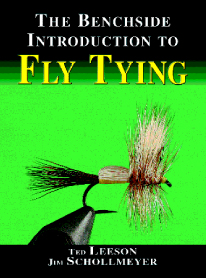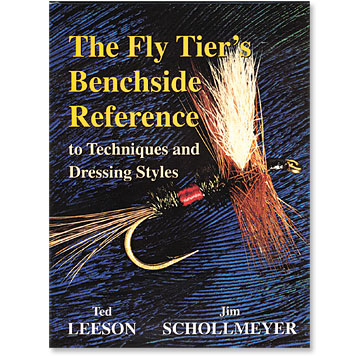Fly Tying 101!
Your source for flyfishing and flycraft resources since 1975.
GETTING STARTED IN FLY TYING
I’ve talked to thousands of customers, scores of professionals and many manufacturers. On my fly tying desk is just about every kind of hair, fur, dubbing, synthetic, wire, foam, legging, hook and, of course tools. I like to try everything I get, and believe me, I have samples of just about everything. Since there are about 125 tools and vises on the next few pages, and it seems overwhelming even to me, I wanted to let our customers know what I “go to” most often - i.e. what ‘stuff’ I use the most and tend to favor. And by the way, I tie just about a thousand flies a year.
Starting with the vise, I like a rotary. Whether it’s “in line” or not, doesn’t matter much for my tying, but I just like to turn the fly occasionally for winding on material and also for inspection of all sides. On my desk sits Peak rotary pedestal vise and it holds all the size hooks I use for freshwater fishing. It never disappointments me. When I travel or do demonstrations, I use Regal’s rotary with a C-clamp. Their “lever action” jaws make it one of the simplest and most pleasant vises to use. I know that the Dyna-Kings are used by many professionals and are also exceptional too, but when I go to fly tying symposiums across the country, I see plenty of “old timers” tying on original Thompsons. Our Pro Vise is most similar and is an excellent choice for a new tyer. In fact, it’s what I used for 20 years before I bought Hook & Hackle. The Apex and the E-Z rotary vises are very popular with our customers for a lower priced rotary and they work extremely well.
As for the other tools, I stick with the basics in most cases. For basic bobbins, I like ones with the brass thumb rest, like our 3800103 and it’s only a few bucks. I’d rather have 3 or 4 of these already spooled up, than have just one bobbin that cost a lot more. If you have trouble with the finer threads breaking, like 8/0 and smaller, I find it is usually because I use too much tension, not because of a groove in the bobbin. If that concerns you, try our ceramic tube bobbin.
Scissors? I’d recommend two pair to start: our arrow scissors with fine points for “close in” trimming and the slightly larger Supreme scissors for making larger cuts, like for synthetic materials and hair. Our “Supreme” is an excellent scissor which will easily take care of most of your needs. They’re stainless steel with gold handles like the kinds that sell for $20. Ours cost $7.50 and I think the quality is identical. You can augment your scissor collection with “Spring”scissors or the “Arrow” scissors for finer cuts. If you must have the best, the Anvil “Ice Tempered” are probably as sharp as you can get. Consider the Anvil 50, 60 or 70’s, shown on page 53.
Bodkins and threaders are “no brainers.” They’re inexpensive and I recommend you get a couple of each because they seem to easily disappear. You can also buy threaders at the local craft store and make a bodkin out of a pin run through a piece of cork. These are less expensive and can be fun to make, too. I always grab just whatever is in front of me.
You’ll more than likely want to learn to whip finish your flies, and the 3800301 on page 54 is all you need. We have the new Hook & Hackle Whip Finisher, 3800HWP, which feels more substantial in the hand and I’m beginning to like it a lot -- my experience with it is limited, but so far I like it a lot! You can also use the ‘half hitch’ tool that is part of our bodkins to finish off a fly. On hair stackers almost any will do the job, but the more you use one, the more finicky you’re likely to become. I think that our new aluminum series is about as good as you can get anywhere. They’re what I use most often. You’ll find them at the top of page 55.
Hackle pliers can be a pain and everyone has their favorites. I find myself reaching for the English style or Non-Skid ones the most. Many, many pro tyers I see are always reaching for the E-ZEE hackle pliers and they’re about as inexpensive as you can get. After some trial and error, you’ll begin to favor certain ones depending upon the feathers you’re using. Do not waste your time trying to pick out the “best” pair from the start.
Hackle guards hold hackles back out of the way during fly head finishing and are widely used by tiers of all levels.
We feature some high quality tool kits will last you for years and are excellent places to start. Naturally, over time, you’ll find yourself adding to these tools here and there -- that’s the best way to do it. Our kit that comes with the reel pouch is exceptional for just $30. It’s item number TOOLBR1. The “Cushion Grip” tools in the leather pouch are also becoming very, very popular. If you go the latter route, you’ll have to purchase hackle pliers and a hair stacker separately. Either way, you won’t be disappointed.
Nothing beats personal instruction. There are many groups which run fly tying classes for a nominal fee-usually the cost of materials. Ask your fly tying buddy for help, if he/she ties. If all those avenues lead nowhere, buy an instructional video and a pattern book.
You find youth clubs, Trout Unlimited chapters, Federation of Fly Fishers chapters, Project Healing Waters programs, fly fishing shops and independent clubs that'll help you get started. The web has countless sets of instructions and videos that will help.
Books - for tying instructions Skip Morris' Fly Tying Made Clear and Simple is one of the nicest we have seen recently. For patterns - There's the American Fly Tying Manual or the super comprehensive Flies: the Best 1000.
These two books are a MUST for the beginner tyer or anyone wanting to advance their skills with fly tying. “Benchside Introduction”is the best way I know to start!! We love these books!! They're expensive, but will get you well on your way to becoming proficient in tying a wide variety of flies.
The Benchside Introduction To
Fly Tying (great for beginners!)
Leeson and Schollmeyer created this new milestone in this comprehensive beginner’s book. 190 color pages with over 1500 beautiful color photos. Just terrific!
Item No. BOOKLS2 Each........45.00
Fly Tier’s Benchside Reference to Techniques and Dressing Styles. Ted Leeson and Jim Schollmeyer. Over 464 pages with 3000 color photos and 400,000 words to describe hundreds of fly tying techniques. Zoom in/print/etc.
Ted Leeson and Jim Schollmeyer. Over 464 pages with 3000 color photos and 400,000 words to describe hundreds of fly tying techniques. Zoom in/print/etc.
Item No. CDROMPC CD ROM Ea. 59.95
Item No. 2100001 BOOK Each....100.00
Click here to check out our Fly Tying Books and Videos
Starting Materials Here's an area where the novice tends to be a hunter gatherer. First, it's very expensive to amass a number of unwanted materials and hooks. Secondly, materials do not last forever and must be cared for. It's best to ease into material collection as your expertise grows.
Below is a very basic list of materials that will allow one to get into basic fly tying with a minimum investment and waste.
- Hooks are covered above.
- Thread. Start with 6/0. Get a spool of black at a minimum. Black thread will be used the most. After that a spool of the earth tones in 6/0 may be a wise investment: olive, grey, brown, cream and beige or tan.
- A jar of head cement.
- A container of dubbing wax.
- Gold wire
- Lead wire medium to start.
- Flat reversible tinsels-Fine, medium and wide.
- Floss-Red
- Standard chenille-best to start with medium in black, yellow, olive and brown
- A package of gold bead heads in a variety of sizes.
- A buck tail piece assortment.
- Calf tail - white
- Grey Squirrel tail.
- A rabbit fur dubbing box.
- A dry fly dubbing box.
- A piece of natural deer hair.
- A piece of light elk hair.
- A piece of moose body hair.
- Hackle-here is another place one could invest hundreds of dollars quickly and foolishly.
- Hackle can be bought by capes, saddles or in packages. Capes can be domestic or imported. If you intend to tie dry fly only - start with either 1/2 no. 3 genetic hackle capes or No. 1 imported capes or if you intend to tie flies primarily in sizes 10, 12 and 14-choose a genetic hackle saddle in grades 1 or 2 (these will yield 2 or more flies per feather).
- Packaged dry fly hackle is very expensive and should be bought only by experienced tyers who need just a few hackles of a particular size and color.
- If you intend to tie only wet flies or nymphs - buy hen necks of the appropriate color.
- For streamers, buy packaged saddle hackles of the desired color.
- Again, if you are starting off just doing 1 or 2 fly patterns, buy the hackle you need for that job only.
- Mallard wing pair - from which you can pluck matched wing pairs.
- Turkey white tipped tails - package.
- Ringneck pheasant tails - package.
- Package of stripped goose in assorted colors (Goose biots).
- Packages of marabou plumes in black, olive and brown.
- A package of peacock herl.
- Packages of mallard flank in natural grey and dyed wood duck.
- A package of gold pheasant tippets and crests.
- A package of silver pheasant body feathers.
- Perhaps a package of partridge hackle.
- Perhaps a package of imitation jungle cock eyes - medium size.
Click here to check out our Fly Tying Vises and Kits
Click here to check out our Fly Tying Materials
Well, that's about it. Now all one has to do is find the time and space to start constructing fishing flies. In no time it's on to more patterns and different kinds of flies.






